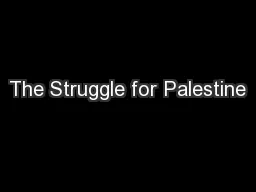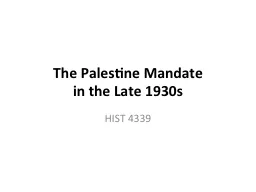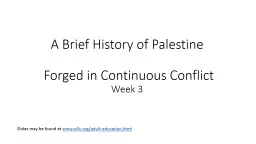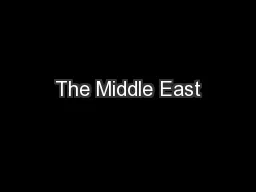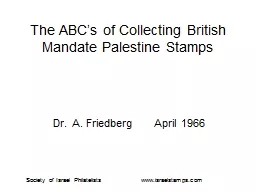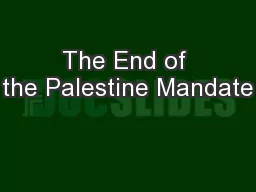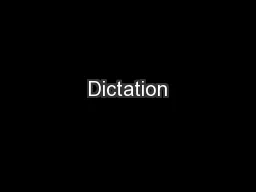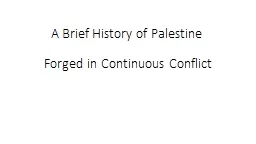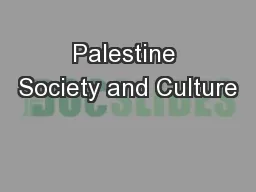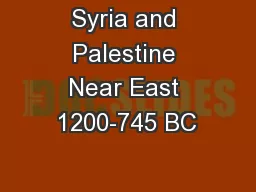PPT-The Struggle for Palestine
Author : trish-goza | Published Date : 2016-02-29
A place for Jews and Arabs I Forming the Israeli State Knesset Israels parliament system Prime Minister head of government First was David BenGurion Current
Presentation Embed Code
Download Presentation
Download Presentation The PPT/PDF document "The Struggle for Palestine" is the property of its rightful owner. Permission is granted to download and print the materials on this website for personal, non-commercial use only, and to display it on your personal computer provided you do not modify the materials and that you retain all copyright notices contained in the materials. By downloading content from our website, you accept the terms of this agreement.
The Struggle for Palestine: Transcript
A place for Jews and Arabs I Forming the Israeli State Knesset Israels parliament system Prime Minister head of government First was David BenGurion Current Prime Minister is Benjamin Netanyahu. Writing the 'Histories' of the Wars of . 1948. Aims. To . learn about the creation of the state of . Israel.. To trace the history of Israel/Palestine from the end of the British Mandate (1945 -1948), through the 1948 Arab-Israeli War until the signing of the armistices between Israel and the Arab states signed in 1949.. Territorial or Existential?. Nevet Basker. March 2011. 1. 2. It’s Both!. Territorial. Existential. 3. TWO. Conflicts in One!. 4. Different objectives. Different players. Different themes. But…. Same land. Apocryphal Writings. General Outline. Introduction, Canon, & Inspiration. Oral Transmission & Early Forms. “. Discovering” the Law (Josiah & Ezra). Apocryphal Writings. Conclusions From Last Week. Directions: . 1. Carefully . re-read the prose text you have chosen, and look for 50–100 words that stand out in the prose passage. Highlight or underline details, words and phrases that you find particularly powerful, moving, or interesting. Note especially examples that reflect your loving feelings or loving feelings of the subject of the prose text. . in the Late 1930s. HIST 4339. Outline. Palestine, pan-Islam, and Indian nationalism. 1936 Arab Uprising. 1937 Peel Commission plan. Challenges to Peel plan. Zionists and Gandhi. Gandhi on European Jewry. . Forged in Continuous Conflict. Week 3. Slides may be found at . www.wllc.org/adult-education.html. Palestine has been controlled by numerous different peoples, including the . Ancient Egyptians, Canaanites, . Background. Late 1800s. Zionism: . Jewish Nationalist . Movement . Want independent state in homeland. World Response. Sympathetic because of Holocaust. UN divides Palestine into Jewish and Arab state. Dr. A. Friedberg April 1966. Society of Israel Philatelists. www.israelstamps.com. The ABC’s of Collecting British Mandate Palestine Stamps. Slide 1. Slide 2. Slide 3. Slide 4. Slide 5. Slide 6. HIST 4339. Midterm Review. Wednesday. Bring sample IDs, . essay questions. Section I: Identifications (20 points each; suggested time: 20 minutes). Complete a total of TWO IDs. You must choose one ID from List One and one from List Two. Write three to four sentences (or more, if you like) for each, . Watch the following passage carefully.. The teacher will hide some words for you to write them again.. Let’s see how smart you are..... Prepared by:T. MuinRabie-Palestine Sch. Dictation(---) Date:--/--/----. . Forged in Continuous Conflict. Palestine has been controlled by numerous different peoples, including the . Ancient Egyptians. , . Canaanites. , . Philistines. , . Tjekker. , . Ancient Israelites. Palestine is the name the Romans gave in the second century C.E. to a region of the present-day Middle East situated on the eastern shore of the Mediterranean Sea west of Jordan . Summary and Interconnections. Babylon 1800-1600 BC. Controlled Assyria. Kassite Babylon 1600-1200 BC. Controlled Assyria until 1365 when Assyria gained some independence until 1200. Phoenicians: vassals . . SYFTET. Göteborgs universitet ska skapa en modern, lättanvänd och . effektiv webbmiljö med fokus på användarnas förväntningar.. 1. ETT UNIVERSITET – EN GEMENSAM WEBB. Innehåll som är intressant för de prioriterade målgrupperna samlas på ett ställe till exempel:.
Download Document
Here is the link to download the presentation.
"The Struggle for Palestine"The content belongs to its owner. You may download and print it for personal use, without modification, and keep all copyright notices. By downloading, you agree to these terms.
Related Documents

